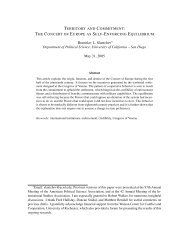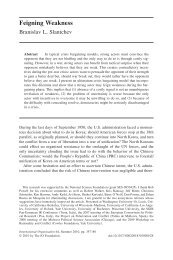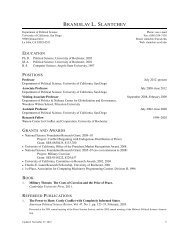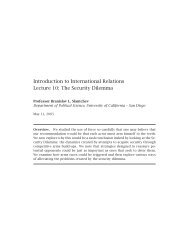Game Theory: Repeated Games - Branislav L. Slantchev (UCSD)
Game Theory: Repeated Games - Branislav L. Slantchev (UCSD)
Game Theory: Repeated Games - Branislav L. Slantchev (UCSD)
You also want an ePaper? Increase the reach of your titles
YUMPU automatically turns print PDFs into web optimized ePapers that Google loves.
Let’s now work our way through a more interesting example. Is (GRIM, GRIM), the strategy<br />
profile where both player use Grim Trigger, a Nash equilibrium? If both players follow GRIM,<br />
the outcome will be cooperation in each period:<br />
whose average discounted value is<br />
(C,C),(C,C),(C,C),...,(C,C),...<br />
∞<br />
(1 − δ) δ t ∞<br />
gi(C, C) = (1 − δ) δ t (2) = 2.<br />
t=0<br />
Consider the best possible deviation for player 1. For such a deviation to be profitable, it<br />
must produce a sequence of action profiles which has defection by some players in some<br />
period. If player 2 follows GRIM, he will not defect until player 1 defects, which implies that<br />
a profitable deviation must involve a defection by player 1. Let τ where τ ∈{0, 1, 2,...}<br />
be the first period in which player 1 defects. Since player 2 follows GRIM, he will play D<br />
from period τ + 1 onward. Therefore, the best deviation for player 1 generates the following<br />
sequence of action profiles: 2<br />
t=0<br />
(C,C),(C,C),...,(C,C) ,(D,C) ,(D,D),(D,D),...,<br />
<br />
τ times<br />
period τ<br />
which generates the following sequence of payoffs for player 1:<br />
2, 2,...,2,<br />
3, 1, 1,....<br />
<br />
τ times<br />
The average discounted value of this sequence is3 <br />
(1 − δ) 2 + δ(2) + δ 2 (2) +···+δ τ−1 (2) + δ τ (3) + δ τ+1 (1) + δ τ+2 <br />
(1) +···<br />
= (1 − δ)<br />
= (1 − δ)<br />
T −1<br />
<br />
δ t (2) + δ T (3) +<br />
t=0<br />
(1 − δ T )(2)<br />
1 − δ<br />
= 2 + δ T T +1<br />
− 2δ<br />
∞<br />
t=T +1<br />
δ t <br />
(1)<br />
+ δ T (3) + δT +1 (1)<br />
1 − δ<br />
Solving the following inequality for δ yields the discount factor necessary to sustain cooperation:<br />
<br />
2 + δ T − 2δ T +1 ≤ 2<br />
δ T T +1<br />
≤ 2δ<br />
δ ≥ 1<br />
2 .<br />
2Note that the first profile is played τ times, from period 0 to period τ − 1 inclusive. That is, if τ = 3, the<br />
(C, C) profile is played in periods 0, 1, and 2 (that is, 3 times). The sum of the payoffs will be τ−1 t=0 δt (2) =<br />
2 t=0 δt (2). That is, notice that the upper limit is τ − 1.<br />
3It might be useful to know that<br />
whenever δ ∈ (0, 1).<br />
T<br />
δ t ∞<br />
= δ t −<br />
t=0<br />
t=0<br />
∞<br />
t=T +1<br />
δ t = 1<br />
1 − δ<br />
8<br />
− δT +1<br />
∞<br />
δ t +1 1 − δT<br />
=<br />
1 − δ<br />
t=0








